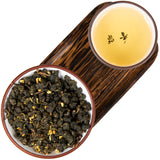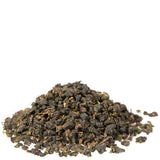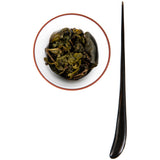The young monk took a sip, paused, and raised his brow. – “Sifu, is this tea… flirting with me?”
Intrigued, Lao Cha looked at him: “Explain?”
– “It’s smooth, sweet, and smells like peaches and apricots. It’s being very... seductive.”
Lao Cha nodded: “Ah. Osmanthus...”
– “Who is Osmanthus?”
– “A flower. A tiny, golden flower that blooms on evergreen shrubs. Very fragrant. In Taiwan, they rest oolong tea with the flowers until the tea picks up the scent.”
The disciple took another sip: “It’s soft. Refreshing. The taste reminds me of baked apples.”
Lao Cha nodded. “That’s Jin Xuan – smooth and round. Refreshment comes from Si Ji Chun. And the fruitiness is delivered by osmanthus flowers. No perfume, no tricks. Just tea sitting with flowers, picking up their mood.”
This lightly scented oolong comes from the mountain slopes of Nantou County in central Taiwan – a region well known for producing soft, fragrant oolongs. This particular tea is a blend of Jin Xuan and Si Ji Chun cultivars, with Jin Xuan comprising most of the base. Jin Xuan (known as the "Milky Oolong" cultivar) brings a creamy, smooth body, while Si Ji Chun (known as "Four Seasons") adds brightness and floral notes.
Osmanthus flowers (桂花 – Gui Hua) aren't well-known outside East Asia. However, they've been used in sweets and Chinese tea for centuries. Osmanthus flowers are tiny, about the size of a pinhead, and bloom in late summer and fall. Their aroma is sweet, floral, and fruity, often compared to apricots or ripe peaches.
To scent this tea, dried osmanthus blossoms are layered with the oolong leaves after the initial processing. For some time, they rest together, allowing the tea to naturally absorb the aroma of the flowers. The flowers are then sifted out, while a few flowers are left in the mix for visual and aromatic effects. No flavoring or essential oils are added.
The resulting tea has a scent reminiscent of ripe stone fruit, with notes of mandarins, apricots, and peach. The flavor leans toward baked apples and dried apricots, with a mellow, smooth mouthfeel and a gentle, sweet finish. It's soft and easy to drink, with a round profile typical of Taiwanese oolongs, subtly accented with a hint of fruit and floral brightness.
Osmanthus oolong is often enjoyed both cold and hot and holds up well to multiple infusions. If you're looking for a naturally scented tea, this is a solid choice – fragrant, balanced, and true to its base.
- Place of Origin: Nantou County, Taiwan
-
Altitude: 400-800m
- Harvest Date: August-September 2024
- Roast: Light
- Aroma: Mandarins, ripe apricots, peaches
- Taste: Apricots and baked apples. Smooth mouthfeel and a light, sweet finish.
- Cultivar: Jin Xuan (金萱) & Si Ji Chun (四季春)
Brewing guidelines:
![]() 205℉ / 95℃
205℉ / 95℃
 1g per 70-100ml
1g per 70-100ml ![]() 3-5min
3-5min
 1g per 20ml
1g per 20ml ![]() 5sec + 5sec for each subsequent infusion
5sec + 5sec for each subsequent infusion





